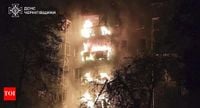Ukraine is bracing for another punishing winter as Russia intensifies its campaign against the country’s energy infrastructure, triggering sweeping blackouts and leaving millions of civilians facing months of unreliable electricity supply. In what officials describe as one of the heaviest attacks since the start of the war, Moscow unleashed a barrage of over 300 drones and more than 30 missiles overnight on October 15-16, 2025, targeting power plants and gas facilities across the nation. The assault, reported by multiple outlets including BBC and AP, marks the fourth consecutive year that Russia has systematically targeted Ukraine’s energy grid as the cold weather sets in.
The latest onslaught is part of a broader pattern that has seen outages in Ukrainian cities stretch up to 12 hours a day during previous winters. This year, the attacks have already destroyed 60% of Ukraine’s gas production capacity, just as the heating season looms and temperatures begin to drop. According to Ukrenergo, the national grid operator, the country is now grappling with a nationwide energy deficit. To prevent a complete collapse of the grid, Ukrenergo has imposed consumption limits on industrial users, scheduled rolling blackouts for households, and introduced emergency power cuts whenever demand surges threaten to overwhelm the system. Residents in regions like Chernihiv Oblast are already experiencing hourly outages, and the situation remains fluid as officials urge the public to conserve electricity to minimize the duration and frequency of blackouts.
The scale and frequency of Russian strikes have escalated sharply this October. In just the first half of the month, Russia carried out at least six attacks on gas facilities and launched a record 26 ballistic missiles on October 16 alone. On October 10, strikes plunged more than 5,800 buildings in Kyiv into darkness and left 7,000 residents without water. Five days later, emergency power cuts swept across seven regions during the morning hours. The UK, in a warning delivered at the OSCE on October 16, cautioned that Russia’s attacks risk “leaving Ukrainians freezing to death in their own homes,” referencing a particularly devastating strike involving 35 missiles and 60 drones against gas facilities in Kharkiv and Poltava.
Ukraine’s gas production has become a new focal point for Russian attacks. On October 3, Moscow launched its largest-ever barrage against gas infrastructure, forcing Kyiv to scramble for nearly €2 billion in emergency gas imports to keep millions of homes heated through the winter. This shift in strategy comes after the expiration of a contract on January 1, 2025, that had allowed Russian gas to be shipped to Europe via Ukrainian pipelines. With that route now closed, Russia has redirected its efforts from targeting the electric power grid, as it did in the first three years of the conflict, to striking at Ukraine’s gas production and storage facilities.
The impact of these attacks is already being felt across the country. Ukrenergo has confirmed that eight regions experienced power outages following the mid-October barrage, with major disruptions reported in Kyiv. DTEK, Ukraine’s largest private energy company, was forced to halt natural gas extraction in the Poltava region due to extensive damage. State-owned Naftogaz said its gas infrastructure had been hit for the sixth time in October, highlighting the relentless nature of the campaign.
President Volodymyr Zelenskyy has repeatedly sounded the alarm over the mounting pressure on Ukraine’s energy sector. Accusing Russia of using cluster munitions and deliberately targeting the same sites to hinder emergency repairs, Zelenskyy stated on Telegram, “This fall, the Russians are using every single day to strike our energy infrastructure.” He added, “Nothing has changed for Russia – it is still terrorizing life in Ukraine. A swarm of drones struck Kryvyi Rih, hitting civilian infrastructure. There were dozens more attack drones in our skies. Missiles were also spotted. In fact, not a single night in recent weeks has passed without Russian strikes on Ukraine. Most of the targets are infrastructure – a systematic campaign of terror against our energy sector.”
Officials in Kyiv have accused Moscow of “weaponizing winter” by targeting energy facilities ahead of the cold season, a claim Russia denies, insisting it only strikes military targets. In response, Ukraine has stepped up its own attacks on Russian oil refineries crucial to Moscow’s war effort. On October 16, the Ukrainian military said it struck the Saratov oil refinery in southern Russia, the second such attack in as many months, according to AP.
The energy crisis is unfolding against a backdrop of high-stakes diplomacy. President Zelenskyy is expected to meet US President Donald Trump in Washington on October 17, where he will seek additional American-made air defense systems, long-range missiles, and joint drone production agreements to help counter Russian attacks. Kyiv is also pushing for tougher sanctions on Moscow. The visit comes amid signs that Trump may increase pressure on Russian President Vladimir Putin to make progress in peace negotiations. After a phone call with Putin on October 16, Trump announced plans to meet the Russian leader in Budapest to “try to bring the war to an end,” though no date has been set. On social media, Trump said he would discuss his conversation with Putin “and much more” during his meeting with Zelenskyy, adding that “great progress was made” during the call.
Meanwhile, US Defense Secretary Pete Hegseth warned on October 15 that if Russia refuses to engage in talks, Washington “will take the steps necessary to impose costs on Russia for its continued aggression.” The US has so far hesitated to send long-range missiles such as Tomahawks, citing concerns about escalation, but the Washington-based Institute for the Study of War noted that such a move would “mirror Russia’s own use of long-range cruise missiles” and not necessarily widen the conflict.
In the midst of the crisis, Ukraine is also looking to strengthen its own defense and technology sectors. The Economy Ministry recently announced a partnership with US aerospace company Bell Textron Inc. to boost domestic aviation technology. The Texas-based firm plans to open an office and testing center in Ukraine and will train local engineers in the United States. During its US visit, a Ukrainian delegation also held talks with major American defense manufacturers, including Lockheed Martin and Raytheon, as Kyiv seeks to bolster its arms industry amid uncertainty over future Western aid.
As winter approaches and the threat of further Russian attacks looms, Ukraine’s resilience is once again being tested. The coming months will determine not only the country’s ability to keep the lights on, but also the endurance of its people and the strength of its international alliances.




